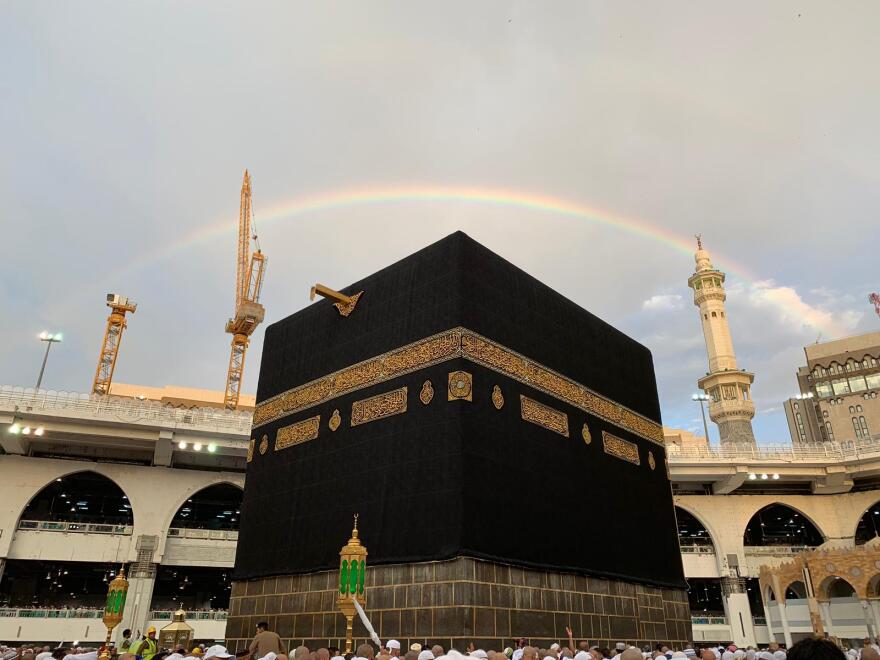Earlier this month, millions of Muslims made their way to Mecca, Saudi Arabia, to participate in the Islamic pilgrimage known as hajj. It’s one of the largest annual gatherings, and there, Muslims who represent hundreds of ethnicities and languages give up their normal lives and dedicate the week to devout worship.
The journey is made over five days during the last month of the Islamic calendar, and Muslims who are physically and financially able to make the trip to Saudi Arabia are required to do so at least once in their lifetime.
The hajj is seen as one of the five pillars of Islam, and its end is marked with one of the two Islamic holidays, Eid al-Adha. On Friday’s St. Louis on the Air, host Sarah Fenske explored the religious obligation and what it entails.
Joining the program were St. Louisans Shahab Mushtaq and Faiza Mushtaq. The husband-and-wife duo were among the millions of Muslims who traveled more than 7,000 miles to attend hajj this year. Joining the conversation was Faizan Syed, executive director of Missouri’s Council on American Islamic Relations.
“It is one of the most amazing pillars in our faith because, in the hajj, Muslims get to experience what it means to really live, almost [like], in God's kingdom,” Syed said. “In the sense that when you get to hajj, everybody is doing the same thing, they're all dressed in a very similar manner and they're all there really to get closer to God Almighty.”
To appear unified, pilgrims dress in a similar manner: Women usually wear a simple loose white dress and a headscarf, while men wear two sheets of white cloth wrapped around the waist and upper body. This helps puts worshippers in a state of ihram, or spiritual unity.
“So the point is that everybody is there for the purpose of worshiping God and everybody is equal; that it doesn't matter [if] you're a king or a multimillionaire, or [if] you're a lowly peasant or farmer. In the eyes of God, you're all equal. And during this time, you are there solely to focus on your worship. So you’re not to be distracted by the material concerns, like, ‘Oh, what am I wearing? And, ‘Are my clothes good enough?’ or things like that,” Shahab Mushtaq said.
There is also no gender segregation during the hajj. Unlike in other mosques, men and women pray together on the same prayer line.

During the pilgrimage, a number of detailed rituals are carried out, such as the circling of the Kaaba, a cube-shaped structure draped in black silk. The structure is believed to have been constructed by the Prophet Abraham from the Old Testament and is the direction Muslims globally pray toward.
On the last day of hajj, people go pray on Mount Arafat, where the Prophet Muhammad is said to have given his final sermon. And this year, it rained – a sure sign of blessings for the pilgrims traveling in 108-degree weather.
“The rain cools things down,” Faiza Mushtaq said. “Like for me, it was the highlight of my trip. I was just standing there praying, [and] I love rain. … It was so beautiful, I can't even explain it.”
Despite the language barriers, Faiza Mushtaq said there was an abundance of hospitality among the travelers.
“You’re being fed from like, all these people [who] were just standing there; they want to give you dates, they want to give you water, they want to give you coffee,” she added.
Back in Missouri and other places where Muslims are not on the pilgrimage, Muslims partake in the “Feast of Sacrifice,” known as Eid al-Adha, which caps off the pilgrimage.
“It really goes back to Abraham. So when Abraham was going to sacrifice his son, Ishmael, we believe that an angel came and basically replaced his son with a ram at that time. So to engage in that same act of sacrifice, Muslims all across the world also do the same ritual,” Syed explained.
The religious reward for completing the pilgrimage is “all of your sins are forgiven,” Shahab Mushtaq said. “And so, for me, especially now, the personal takeaway is that I have to make a more concerted effort to be a better person to try to adhere to the dictates of [the] religion in a more focused manner, and not repeat the same mistakes … you've been given a second chance.”
Listen to the full discussion to learn about what it’s like to go on hajj:
Faizan Syed on leaving CAIR-MO
After eight years of leading CAIR-MO, Syed is set to leave the organization to become the new executive director of CAIR-Dallas-Fort Worth.
“I'm going to miss a lot of people here [in St. Louis]. … But I'm excited because Texas is the second-largest state in the country, it’s rapidly demographically changing,” Syed said. “I'm hoping to go to that area to really empower the Muslim community there to not only impact the state of Texas, but through that, possibly impact the greater country and society as well. … And I'll be back and forth, so nobody can get rid of me that easily.”
“St. Louis on the Air” brings you the stories of St. Louis and the people who live, work and create in our region. The show is hosted by Sarah Fenske and produced by Alex Heuer, Emily Woodbury, Evie Hemphill, Lara Hamdan and Alexis Moore. The engineer is Aaron Doerr, and production assistance is provided by Charlie McDonald.
Send questions and comments about this story to feedback@stlpublicradio.org.



